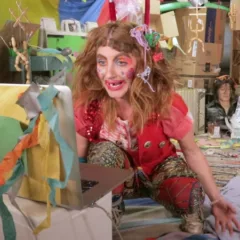THE PEELING paint and uneven floors of an old industrial building are not for everyone. But Globe Dye Works, an old textile-dye factory in Frankford, is the perfect backdrop for 17 sculptors in the new show “Catagenesis.”
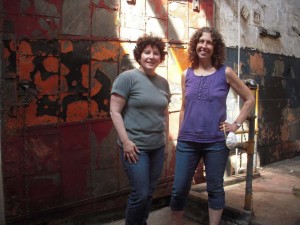
Leslie Kaufman, president of Philadelphia Sculptors, pegged Globe for her group’s 2012 show. Currently being converted to a mixed-use building for artist studios and small businesses, Globe is full of history and just funky enough to hold a great art show. Philadelphia Sculptors, a nonprofit with 250 members, was founded in 1996. The group does not have an exhibit space, which Kaufman says has kept them nimble but also a bit under the radar.
Kaufman, who co-organized “Catagenesis” with artist/curator Cheryl Harper, wanted to make a splash this year with big installations related to Philadelphia’s postindustrial past. Thus she wanted the Globe just as it was, pre-makeover. “The concept for the show was to use the space as we found it,” she said.
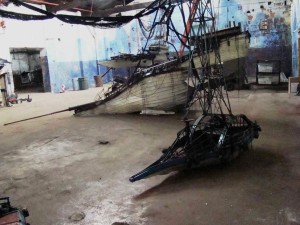
Mounting art exhibits in old buildings isn’t a new idea, but it’s a good one. Not only does the art look great in historic spaces, but show visitors get to see old buildings in new ways as they learn about the history of their city. Eastern State Penitentiary brought the trend to Philadelphia in 1995 with “Prison Sentences,” which installed art in prison cells and corridors of the then-crumbling prison. Hard hats were required headgear for visitors to that first show.
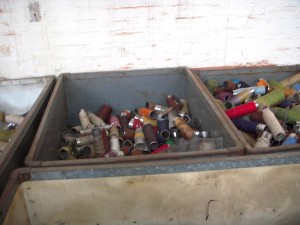
Globe, which is nowhere near crumbling, donated unrefurbished space on its ground floor for the show, agreeing to hold off restoration for two years while the sculpture event came together. As Charlie Abdo, one of Globe’s owners and managing partners, said, “We thought it would be a onetime, once-in-a-lifetime possibility. The spaces [where the art will be] are undeveloped now, but they will be developed in the future.” Besides donated space, Abdo had some of his employees help the sculptors install their works.
“Catagenesis,” a geological term referring to transformation of one substance into another, is a show of installation art – sculpture made up of many individual pieces that take over a space like an interesting, benign infestation.
References to the factory’s past crop up in all the works. One piece, by two Troy, N.Y., artists, Jacqueline Weaver and Timothy McMurray, involves 35 pounds of mercerized cotton thread unspooled and dangling from the ceiling in a 20-foot cube. Colored lights projected onto the cube play off Globe’s history with colored dyes and with mercerization, a process that allows cotton threads to better absorb color. Globe was a mercerization specialist, according to Harper.
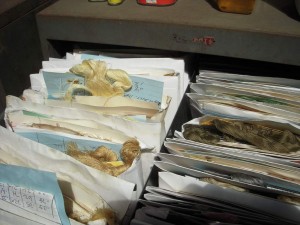
In case you’re wondering, the 35 pounds of thread came wound up on spools and bobbins that the artists had to unwind to make their piece. “We walked 35 miles to unspool it,” Weaver said with a laugh.
Another part of the “Catagenesis” show is New Jersey artist Scott Pellnat’s “Low Tide or Dance of the Seven Veils,” a dangling fleet of fantasy ships that’s a nod to the boats that sailed up Little Tacony Creek (now hidden under Torresdale Avenue) carrying raw materials such as indigo and sumac from which the dyes were made.
Cuing on the noise of factory work, Joe Leroux – who lives in and has a studio in the building – is creating a harp. The instrument’s sound will not be the celestial music typically associated with a harp but other, more discordant and ghostly melodies.
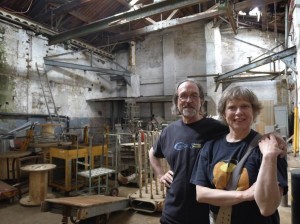
Philadelphia duo John Phillips and Carolyn Healy, known for light and video installations in raw spaces, have been working in the Globe since February. Their immersive environment uses found materials from the building, along with colored strobe lights and a video projection.
A performance at the show’s opening by Christine Altman will deal with the role of women textile workers, a job Altman’s great-grandmother had.
Kaufman and Harper are making a 20-minute video about Globe’s history, which is also Philadelphia’s. Globe, a onetime economic powerhouse in the textile sector, was in business from 1865 to 2005, and at its peak employed 225 workers. The video, filmed and edited by Ben Graeff, includes interviews with members of the Greenwood family, who owned and ran Globe through five generations, and with others who worked there.
A Washington, D.C., consulting firm interested in Globe’s history, Growth Strategy, volunteered to cover the video’s cost and to fund the opening reception for the show. Other funding came from small grants through various foundations and the Philadelphia Cultural Fund.
The Globe partners are rehabbing their huge place in stages, as tenants come to them. Right now they have 28 tenants, Abdo said, a combination of artists and small creative businesses and shops. “We’re kind of developing a niche for food, a specialty food niche,” he said. They are finishing a space for Birch Tree Catering (which will cater the “Catagenesis” opening). Other food tenants are Cupcake Wonderland and Lovebar Chocolates. Abdo, who calls himself a building lover, said he appreciates the industrial charm of Globe. He decided on the art and business mix for the building because “I knew we could do nice studio space for less than the market average.” Studios rent from 50 cents to $1 a square foot. Right now, they are out of rentable space, he said, but he’s eager to convert more space into artist studios.
“Catagenesis,” to Oct. 21. Closing reception 4-6 p.m. Oct. 21. Lecture: “Rainbow Makers: The Quest for the Perfect Color” 3 p.m. Oct. 21. Globe Dye Works, 4500 Worth St., globedyeworks.com, philasculptors.org. Check out the Catagenesis blog for behind the scenes photos and information.
This article ran on Sept 7, 2012, in Philadelphia Daily News as part of Art Attack, a partnership with Drexel University supported by a grant from the Knight/NEA Community Arts Journalism Challenge, administered by the Greater Philadelphia Cultural Alliance.



